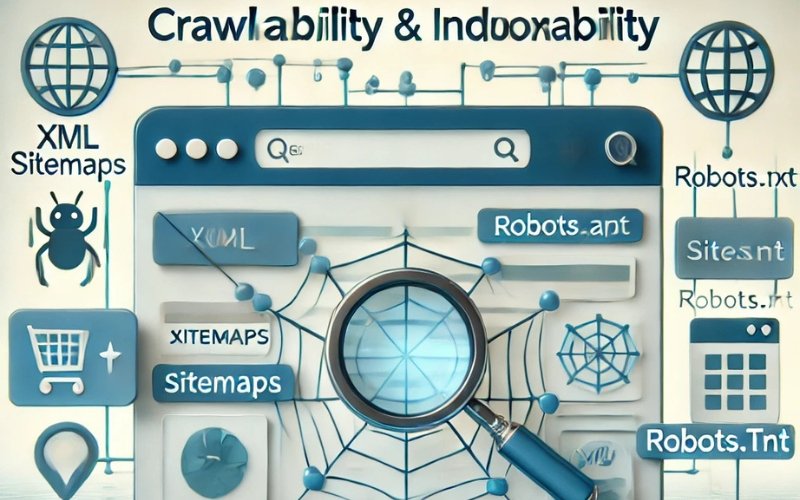Search engines, like Google, use bots or spiders to crawl the web, discovering and indexing content. The terms “crawlability” and “indexability” refer to how well these bots can access and process your site’s content for inclusion in search results. Without proper crawlability and indexability, even the most well-designed and content-rich website will struggle to rank well because search engines may not be able to access, understand, or display its content. To ensure success, it’s essential to optimize for crawlability so bots can easily navigate your site.
Optimizing these two factors is crucial to ensure that your pages not only get crawled but also appear in relevant search engine results pages (SERPs). Focusing on how to optimize for crawlability ensures that search engines can effectively understand your content structure and index it correctly. Here’s a detailed guide on what crawlability and indexability are, why they’re important, and how you can optimize for crawlability to improve your site’s visibility and ranking. By making this a priority, you can create a site that search engines can seamlessly crawl and index, ensuring maximum discoverability.
What Is Crawlability?

Crawlability is the ability of search engine bots, such as Google’s Googlebot, to crawl through your website’s content. During crawling, bots follow links, accessing and recording the pages they find. To optimize for crawlability, these bots rely on internal and external links to navigate from page to page across the web, gathering information for search engines to use when determining rankings.
If bots cannot crawl your site correctly, they won’t be able to index your content. Even if you’ve optimized everything else (such as keywords, content quality, and user experience), your pages won’t appear in search results. Ensuring your site is fully crawlable is a key step to optimize for crawlability and achieving SEO success.
Remember, the better you optimize for crawlability, the more effectively search engines can access and rank your content. Focusing on this foundational aspect ensures your website remains visible and competitive.
What Is Indexability?

Indexability refers to whether the crawled content can actually be added to a search engine’s index and subsequently appear in search results. Indexing is when search engines store your web pages in their database and decide if your content is relevant and valuable enough to appear in search results for certain queries.
Pages that can’t be indexed won’t show up in search results, even if they’ve been crawled by search engine bots. Just because a page is crawlable doesn’t necessarily mean it’s indexable. Various factors, such as a “noindex” tag or blocked pages, can prevent a page from being indexed.
Steps to Improve Crawlability and Indexability

Now that we understand the importance of crawlability and indexability, let’s look at practical steps you can take to optimize your website for both.
1. Submit an XML Sitemap
An XML sitemap is essentially a roadmap of your website for search engines, designed to optimize for crawlability. It lists all the important pages on your site, guiding bots through the content you want to be indexed. A well-structured XML sitemap helps search engines prioritize which pages to crawl and ensures that all essential content is accessible.
Why It’s Important:
Submitting a sitemap helps Google and other search engines find your pages faster and ensures that even deep, hard-to-reach pages get crawled. It’s particularly useful for larger websites with complex structures or newly launched websites that need a jump-start in getting indexed, ensuring you optimize for crawlability effectively.
How to Do It:
- Create an XML sitemap using a tool like Yoast SEO (for WordPress users) or Screaming Frog to optimize for crawlability.
- Submit the sitemap via Google Search Console and Bing Webmaster Tools.
- Monitor the submission status and correct any errors to continually optimize for crawlability.
2. Review Your Robots.txt File
The robots.txt file is a simple text file located in the root of your website that tells search engines which pages or sections they are allowed to crawl and index. It plays a crucial role in helping you optimize for crawlability by ensuring search engines focus on the most relevant parts of your site, avoiding wasted resources on unnecessary pages.
Why It’s Important:
An incorrectly configured robots.txt file can accidentally block critical pages from being crawled and indexed, which can harm your SEO. For instance, you may unintentionally block all crawlers from accessing your site, which would prevent your pages from appearing in search results. Ensuring this file helps you optimize for crawlability is key to maintaining visibility.
How to Do It:
- Ensure you are not disallowing important pages in the robots.txt file, as this impacts how you optimize for crawlability across your site.
- Use the robots.txt Tester in Google Search Console to check for any issues and validate changes that help you optimize for crawlability effectively.
- Only block pages irrelevant to users or search engines, such as private sections or duplicate content, which ensures the remaining resources are used to optimize for crawlability in critical areas.
3. Fix Crawl Errors
Crawl errors occur when search engine bots try to access a page but are unsuccessful. This can happen for various reasons, such as broken links, server errors, or incorrect URL structures. These errors can prevent search engines from fully crawling your website, making it harder to optimize for crawlability and resulting in pages not being indexed.
Why It’s Important:
If Google encounters too many crawl errors, it may assume that your site is poorly maintained, which could affect your rankings. Fixing crawl errors not only helps search engines understand your site better but also improves the user experience by ensuring visitors aren’t landing on broken pages. Addressing these issues is a vital part of any effort to optimize for crawlability and improve search engine visibility.
How to Do It:
- Regularly check for crawl errors in Google Search Console under the “Coverage” report.
- Address 404 errors by redirecting broken links using 301 redirects to ensure smooth navigation and optimize for crawlability.
- Resolve any server issues that might prevent bots from accessing your content.
- Ensure all your URLs are properly formatted and lead to active pages, further helping to optimize for crawlability across your sit.
4. Optimize Internal Linking
Internal linking is a key aspect of both crawlability and indexability. When you link your content internally, you’re guiding search engine bots through your website, ensuring they discover all important pages. This process also helps spread authority (PageRank) across your site, which can improve rankings for more than just your homepage.
Why It’s Important:
Internal linking ensures that search engine bots can easily navigate your website, discovering new or deeper pages that might otherwise go unnoticed. This is especially crucial for large websites or websites with a complex hierarchy, where important pages could be buried several layers deep.
How to Do It:
- Link to important pages from your homepage or other high-authority pages.
- Use descriptive, keyword-rich anchor text for internal links.
- Create content hubs, where one cornerstone article links to various sub-articles, creating a logical and easy-to-crawl structure.
- Ensure no important page is more than three clicks away from your homepage.
5. Manage Crawl Budget
Your website’s crawl budget refers to the number of pages search engine bots will crawl on your site within a given timeframe. This budget is determined by factors such as your site’s size, speed, and overall health. For larger websites, managing the crawl budget is essential to ensure that search engines are focusing on your most important pages.
Why It’s Important:
If search engines spend their entire crawl budget on irrelevant or low-value pages (like archives or tags), they may not reach the pages you actually want to rank. By managing your crawl budget, you ensure that search engines focus their attention on high-priority content.
How to Do It:
- Block irrelevant or duplicate pages (like tag archives) in your robots.txt file.
- Prioritize the crawling of high-quality content by maintaining a clean URL structure.
- Regularly audit your website to remove or redirect outdated or unnecessary pages.
Conclusion
Crawlability and indexability are foundational aspects of technical SEO. Without proper optimization, search engines may struggle to find and rank your content, regardless of how well it’s written or optimized for keywords. By focusing on improving crawlability through tactics like submitting an XML sitemap, optimizing internal linking, fixing crawl errors, and managing your robots.txt file, you ensure that search engines can access, crawl, and index your content efficiently. The end result is a website that performs better in search engine rankings and delivers a better user experience.

